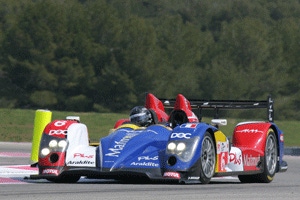June 18, 2010

In a fast-rising convergence of functional plastics andelectronics, a flexible OLED (organic light-emitting diode) on foil debutedthis week on a LeMans race car.
The technology moved out of the lab as part of amulti-company, multi-university effort that incubated in the Holst Centre, an independentopen-innovation R&D community in Eindhoven, The Netherlands. The OLEDtechnology innovation was part of a trend toward pre-competitive engineering collaborationin which major companies can avoid risk, but still profit from their inventions.
"One of our targets has been to make OLEDs twice asefficient as they had been previously," says Paul Blom, scientificdirector of the Holst Centre. Experts feel that once the technology isoptimized over the next three years, these lightweight, flexible devices willuse as much as 70 percent less energy than currently used, conventional lightsources.
In a demonstration project, OLEDs were embedded in acarbon-fiber-reinforced plastic composite used to make side mirrors on a carfrom the French racing team Oreca, which finished fourth in the 24-hour Frenchcompetition, also known as the "GrandPrix of Endurance."
"You can easily integrate OLEDs into three-dimensionalstructures, unlike other types of lighting," says Bernhard Sailer, a global marketingmanager of Huntsman Advanced Materials,one of the participants in the Holst project. Huntsman developed new barriertechnology to help prevent the development of black spots caused by penetrationof water into the functional polymer layers.
Pierre Seze, composite department manager at Oreca, says:"The integration of the OLED system in our carbon fiber pre-preg representsseveral advantages for our race car. The first one is the weight. Thistechnology fit perfectly with the very demanding constraints of endurance racesuch Le Mans 24 Hours."
Sailer said Huntsman wanted to demonstrate with themirror project that while OLEDs are not yet ready for prime time, they aremoving closer. He thinks commercial applications are two to three years away andprobably will begin with niche applications, such as ski boots, where buyersare not extremely cost sensitive.
While Huntsman is pursuing a polymer approach to barrierprotection, a research team at Enindhoven University, also a Holst Centrecollaborator, is exploring the potential of plasma-enhanced deposition andetching to provide protection for flexible electronic devices, including OLEDs.A lab headed by M.C.M van de Sanden is exploring the optimal combination of organicand inorganic materials that can be deposited with plasma techniques.
Another important target in the commercialization ofOLEDs is development of roll-to-roll processing technology using webs ofpolymers. Testing is now taking place on the much slower sheet-to-sheet system.
Thermal sensitivity of plastics limits the process nowprimarily to a very expensive polymer, polyimide. Holst researchers want todevelop roll-to-roll processes for polyethylene naphthalene (PEN), or evenother less expensive members of the polyester family.
In one major leap, a company called NeoDec that wasrecently spun out of the research cocoon at Holst, says it has developed apolymer printing technology that takes place at room temperature, theoreticallycreating the opportunity to use most thermoplastics.
Some of the research projects at the Holst Centre arefunded by the Dutch Polymer Institute, an organization funded partly by theDutch government and partly by company and university researchers. CorporateR&D budgets shrank due to extreme automotive cost cutting in the 1990s, andcompanies agreed to conduct early research on projects such as flexibleelectronics as a group.
"It began as an experiment, and after 13 years, we havehad significant success," said Jacques Joosten, director of the Dutch Polymer Institute. He pointed to two projects on flexibleelectronics as examples: the plasma deposition work and a separate projectaimed at improving efficiency of polymer systems in photovoltaic cells.
The Holst Centre was set up in 2005 by IMEC (Flanders,Belgium) and TNO (The Netherlands) with support from the Dutch Ministry ofEconomic Affairs and the Government of Flanders. It is named after GillesHolst, a Dutch pioneer in research and development and the first director ofPhilips Research.
OLEDs Debut on LeMans Race Car_B
About the Author(s)
You May Also Like





